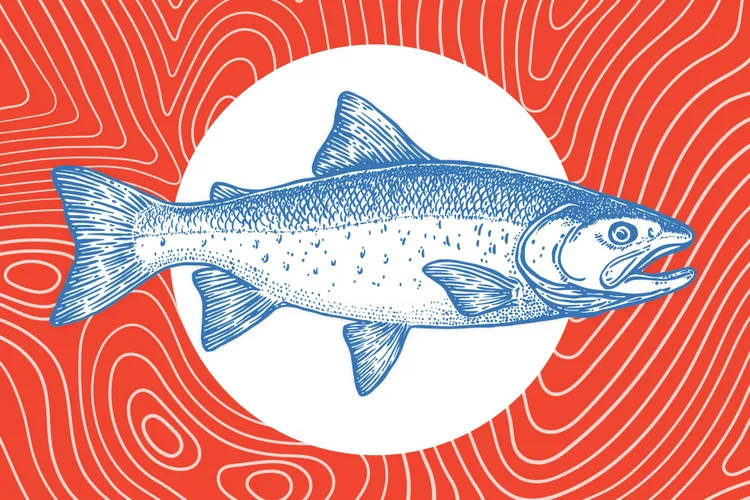Why Farmed Salmon Isn't as Bad as You Think
Credit: Food & Wine / Photo Illustration by Doan Nguyen / Getty Images
Source: Food&Wine /. Author: Kim Cross
Key points
Farmed salmon gets a bad rap, but when done right, it’s a sustainable and affordable source of healthy protein.
Nutritionally, wild sockeye and king salmon are more nutrient-dense and are higher in omega-3s than farmed Atlantic salmon, but farmed Atlantic salmon has similar levels of protein and fat to wild sockeye and king.
Look for labels from the Aquaculture Stewardship Council (ASC) or Best Aquaculture Practices (BAP), or use the Seafood Watch app to make sure farmed salmon is sustainably produced.
In the U.S., 97% of salmon produced is wild-caught, thanks to the abundance of Alaska’s wild sockeye. But when it comes to consumption, Americans mostly buy farmed Atlantic salmon — two-thirds of which is imported. It’s no wonder: most of the world’s salmon is farmed. Of the 8.8 billion pounds of salmon produced worldwide, 82% is farmed. Most of that is Atlantic salmon farmed in Norway (54%) or Chile (26%).
And that’s not necessarily a bad thing.
“Farmed fish have gotten a bad rap,” says Ray Hilborn, a professor in the University of Washington’s School of Aquatic and Fishery Sciences. “Whenever you ask, ‘What should I eat?’ You should ask, ‘What’s the alternative, and what would its environmental impact be?’”
The sustainability case for farmed salmon
If the alternative is beef, chicken, or pork, any fish is better in all the dimensions related to sustainability. Farmed salmon use generally one-third to one-half of the water and land required to grow an equivalent pound of chicken, Hilborn says, and one-tenth of what’s needed for beef. (Wild salmon is even more sustainable. Hilborn conducted a study and found that selling Alaskan salmon in Europe will almost always have a lower carbon footprint than selling farmed Norwegian salmon there.)
“Fish is being held to a much higher standard than other foods,” he adds. “There’s nothing like this when you go to the meat counter or vegetable counter.”
I consulted Barton Seaver, a chef, author, and sustainable seafood expert from Maine. Once a “card-carrying vociferous chef” who only served wild fish, he opened his mind to sustainable aquaculture when saw how it could benefit public health by making fish — and its nutritional benefits — more accessible and affordable.
“Farmed fish have gotten a bad rap. Whenever you ask, ‘What should I eat?’ You should ask, ‘What’s the alternative, and what would its environmental impact be?’”
— Ray Hilborn, Professor, School of Aquatic and Fishery Sciences at University of Washington
Is wild salmon healthier than farmed salmon?
Nutritionally, wild salmon has an edge, but farmed also delivers. A 2020 Canadian study analyzed the nutritional composition of six types of farmed and wild salmon and found wild sockeye and wild king (aka chinook) were the most nutrient-dense and had the highest omega-3 content, with the greatest levels of DHA (essential for brain development) and EPA (linked to reduced incidence of heart disease). Farmed Atlantic had similar levels of protein and fat to wild sockeye and king. Mercury was highest in farmed organic king (though still at a level considered safe by the U.S. Environmental Protection Agency) and lowest in farmed Atlantic.
Eating Like a Salmon Is Better Than Eating Actual Salmon, Study Finds
What about net pens?
Aquaculture has made great strides in the 60 or so years since the first salmon net pens went into the waters around Norway. Not unlike CAFOs (concentrated animal feeding operations), the density of many such salmon farms — floating cages where farmed salmon are raised in the sea — can contribute to a variety of problems: disease, antibiotic and chemical use, and effluent waste released into the environment. Escaped farmed fish can threaten wild populations by competing for food, spreading disease, and altering the wild gene pool.
But a risky practice in one environment can be a best practice in another. Net pens were banned this year in Washington state to protect wild king salmon populations in the Puget Sound, where orcas depend on them for food. In New Zealand, there are almost no wild salmon populations to threaten, so farmed king raised in net pens here are rated a green “best choice” by Seafood Watch, the Monterey Bay Aquarium program that offers science-based recommendations about sustainable seafood.
The next evolution in sustainable farmed salmon includes land-locked fish farms that use Recirculating Aquaculture Systems (RAS), indoor tank-based systems that raise fish away from the ocean and closer to population centers. Compared to net pens, RAS farms are closed systems that eliminate the risk of farmed fish escaping into the wild. RAS farms recirculate water, use less energy, and make it easier to control disease.
Lab-Grown Salmon Is Here, and It’s Got FDA Approval
How to shop smarter for farmed salmon
There are three easy steps you can take to make sure the farmed salmon you’re buying is sustainable.
Look for third-party certification logos from the Aquaculture Stewardship Council (ASC) or Best Aquaculture Practices (BAP). These organizations set rigorous guidelines for third-party auditors who scrutinize the environmental and social impacts of farming practices. ASC tracks the fish through the entire supply chain. Around one-third of farmed salmon is ASC-certified.
If you can’t find third-party logos, research your grocery store’s seafood policy by searching the website or asking a manager. Some stores, such as Albertsons, develop their own policies and labels.
Finally, check the website for Seafood Watch, the Monterey Bay Aquarium program that offers science-based recommendations about sustainable seafood, and download the Seafood Watch app to research options on the go. Look for a rating of green or yellow.

